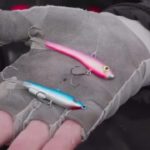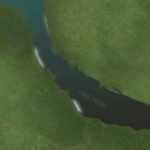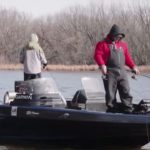The Perch-Bluegill Connection
Dave Genz revolutionized ice fishing by seeing what the sport could be, rather than what it always had been. By noticing what others miss, he continues to help us catch nice fish. One of Genz’s more recent connect-the-dots theories has to do with jumbo perch and big bluegills. In essence, it’s find one and find the other, in waters that hold both.
Before we get started, just a quick note to say that this is something we have not written about before. Dave didn’t want to talk about it in print until he was convinced it’s something you can take to the bank no matter where you fish. It’s a dynamic that is still a theory, but it has held true for years, in many lakes across the Ice Belt…
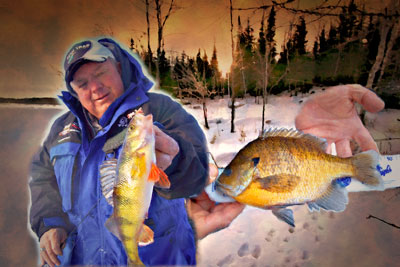 Dave Genz revolutionized ice fishing by seeing what the sport could be, rather than what it always had been. By noticing what others miss, he continues to help us catch nice fish.
Dave Genz revolutionized ice fishing by seeing what the sport could be, rather than what it always had been. By noticing what others miss, he continues to help us catch nice fish.
One of Genz’s more recent connect-the-dots theories has to do with jumbo perch and big bluegills. In essence, it’s find one and find the other, in waters that hold both.
Among ice anglers, these are two of the most prized specimens. When they come in a mixed bag, it makes for a memorable day on the ice. Over the years, Dave has come to see that it’s worth the effort to seek bull-nosed bluegills where big perch swim, and vice versa.
“Granted, there are lakes that only have one or the other,” says Genz, folding his hands together and looking off into his memory banks. “I can think of lakes in South Dakota that don’t have weeds, and they only have perch. But there are plenty of places with both.
“On Okoboji (Iowa), the perch size is good, and it has really nice ‘gills. Cutfoot (part of Lake Winnibigoshish), Tulibee Lake, Reno, Blackduck (all in Minnesota) have nice perch and big bluegills. In New York, there’s Silver Lake, with decent bluegills and nice perch.”
There are others, including numerous lakes so small that Dave wrestles with whether to name them, which he chooses not to do. The big takeaway, no matter where you fish, is that this connection between bluegills and perch is worth looking for.
“If the perch are big, the ‘gills are, too,” says Genz.
A Working Theory on the Dynamics
So how is it that Genz’s theory tying jumbo perch to big bluegills might work?
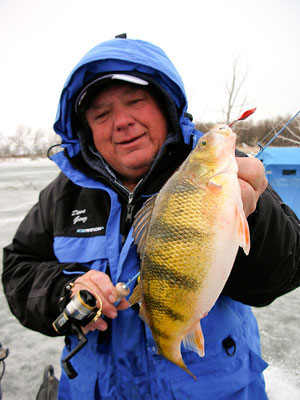 After all, when both species reach grownup size, neither is a threat to the other. And, truthfully, it’s rare to sit and jig in one hole, catch a big bluegill on one drop, then a jumbo perch on the next drop, then a couple ‘gills followed by another perch. They don’t really run under the same circles, you might say… a little ice fishing humor there.
After all, when both species reach grownup size, neither is a threat to the other. And, truthfully, it’s rare to sit and jig in one hole, catch a big bluegill on one drop, then a jumbo perch on the next drop, then a couple ‘gills followed by another perch. They don’t really run under the same circles, you might say… a little ice fishing humor there.
“Stunting is so common,” says Genz, “for both perch and bluegills.”
(Stunting is a term that means there are zillions of little fish, but few big ones. When there are zillions of little fish, those cumulative little fish take up the lake’s capacity to sustain fish life, and it becomes rare for any individual fish to grow large.)
“Once a lake has a stunting problem,” Genz continues, “it’s tough to fix it. But in lakes that have these larger perch, the big perch control stunting of bluegills because they eat the small bluegills. That keeps the bluegill numbers down, which lets more of them get big.
“That’s why lakes that have large keeper-size perch are also the key lakes for large bluegills.”
Genz believes that once perch grow to about 8 inches in size, they can become baby bluegill eating machines. In order to have this grazing impact, the big perch and little bluegills don’t have to occupy the same places every day. They just need to come into contact with each other at various points during the year. All predators are opportunistic, and big perch will eat little sunfish when they are available.
The natural forces regulating predator and prey adjust bluegill numbers downward, which leaves abundant food per bluegill. This naturally creates plump ‘gills among those that escape the jaws of big perch and other predators. Surviving bluegills find plenty to eat, and grow up to be saucers in their own right.
So really, the lake has to be a natural producer of big perch, and have the right kind of habitat to support bluegills as well, in order for this dynamic to play out. There are plenty of lakes loaded up with “little green suckers,” which is Dave’s technical term for small perch you can see through if you hold them up to the sun while unhooking them.
Catching Jumbos and Bulls
When you find a lake that has big perch, suspect that it could hold big bluegills, too. But don’t expect to be able to consistently catch both in the same areas.
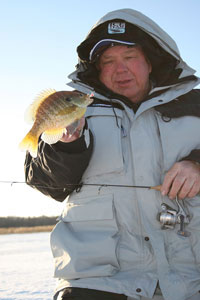 Here are some thoughts from Dave on how to find each, under the ice.
Here are some thoughts from Dave on how to find each, under the ice.
“Perch tend to be deeper (than big bluegills),” he begins. “Perch are more bottom-oriented. They’ll actually root things out of the bottom. Bluegills can be in a wider variety of places, you might say. They’ll feed on suspended food at different heights in the water column. Compared to perch, you’ll also find bluegills more commonly around old weed beds, feeding off the weed stalks. Think deeper flats for big perch, and weedbeds for bluegills.”
At this point, the question begs: but what about those sticky-bottom areas that Genz taught us about? Those places, mostly in the middle depths, where bottom consistency is just right to support burrowing insect life. Dave talks about finding big bluegills on these sticky-bottom areas, often the biggest ‘gills in the lake. Wouldn’t that mean you could easily find big perch and big ‘gills in the same sticky-bottom spots?
“Not really,” says Genz. “The bluegills are there, but they’re more on the side of the break, not even all the way to the base of the break (where a dropoff levels off into a basin area, where sediments accumulate, the ‘start’ of a sticky-bottom area). Bluegills seem to choose to be on the side of the break, and feed into the sides.
“Perch are more adjusted to feed straight down, so they can tip their noses down into the bottom and root things out of the bottom. That’s why you find perch out on the flats. Those tendencies keep the fish mostly separated from each other. I have not been on a bite where you catch a nice bluegill, then a nice perch, then another bluegill. The other day, I caught an 11-inch perch where I was catching bluegills, but it was just that one.”
Note: Dave Genz, known as Mr. Ice Fishing, was the primary driver of the modern ice fishing revolution. He has been enshrined in the National Fresh Water Fishing Hall of Fame and Minnesota Fishing Hall of Fame for his contributions to the sport. For more fishing tips, go to www.davegenz.com.


